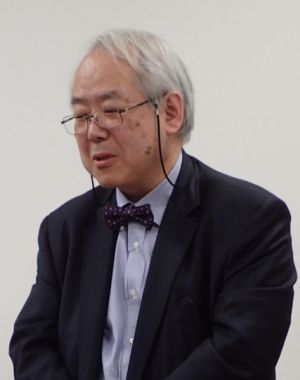CONTENTS |
1. Information |
2. Column |
|
(Professor, IER, Hitotsubashi University)
|
 |
 |
Reflections on Institute of Economic Research’s activities: After serving two years as the Director of IER |
|
|
|
|
I. My contributions to IER |
|
(1) Initiated a peer review process of last five year’s IER activities by inviting a team of four eminent external reviewers and obtained their valuable feedback.
(2) Promoted the Joint Usage and Research Center Programs within IER. We now accept a lot more applications involving collaborative research with domestic and international researchers on a wide range of topics.
(3) Acquired large Science Research Funds in terms of amounts and numbers.
(4) Promoted joint research agreements with Kyoto University, Osaka University, Keio University, Economic and Social Research Institute (Cabinet Office), Research Institute of Economy, Trade and Industry (Ministry of Economy, Trade and Industry), Institute for Monetary and Economic Studies (Bank of Japan), National Institute of Population and Social Security Research (Ministry of Health, Labour and Welfare), and NLI Research Institute (Nippon Life Insurance). In addition, joint seminars with Economic and Social Research Institute were held regularly.
(5) Applied for some competitive government research projects.
(6) Organized international conferences and research workshops. Also, invited foreign and domestic researchers to conduct joint research with IER researchers.
|
|
|
II. How does IER function? |
|
As the Director, my main concerns were to make IER active in terms of research, publications, and organizing conferences, to keep IER open to everyone, and to put IER as the primary partner with other research institutes and academic society.
The case in point is the Human Development and Capability Association Conference 2016 held at Hitotsubashi University on September 1-3, 2016. Over several hundreds of researchers from all over the world participated in this event. The list of notable guest speakers included Amartya Sen and other eminent economists, philosophers, sociologists, political scientists and environmental researchers. We gathered together and discussed various issues, rarely happens in other universities in Japan. Reiko Goto and Ryo Kambayashi brilliantly organized this event and helped turn it into a big success. This is just one example. We continue to create opportunities to do research and exchange ideas with individuals from different disciplines.
|
|
|
III. A role model for IER |
|
To me, the role model for IER is the Institute for Industrial Economics (IDEI) at the University of Toulouse 1 Capitol. IDEI is a world class partnership-based research institute that was established by Jean Jacque Laffont in 1990 and followed by Jean Tirole.
IDEI’s dual objective:
(1) To enable the group of economists at the University of Toulouse to compete at the international level,
(2) To offer businesses and administration an interface between their activities and economic research.
By addressing the theoretical and practical economic issues faced by private and publicly owned companies, IDEI allows decision makers to benefit from the cutting edge tools in the field of economic research.
Not to mention, the University of Toulouse is a national university and the French education and academic system is highly centralized and controlled by a small number of bureaucrats in Paris. A typical elite education in France is given to a very limited number of students at Grandes Écoles such as École nationale d'administration (ENA in short). These educational institutions are not regarded as universities but as high ranked professional schools. Laffont and Tirole try to challenge these highly established educational institutions in France in many ways. Problems they face are similar to the ones that we face at IER, Hitotsubashi University. For example, both France and Japan are non-English speaking countries with very strong academic traditions of its own. At the same time, both are facing international competitions in academic research and student admissions with, mainly English speaking countries including the USA and the UK. In addition, both are facing shrinking budget constraints from the respective central government. At the same time, both of these countries are committed to conduct leading research and are expected to rank high by the global standard.
Laffont and Tirole’s solutions to these problems are very instructive to us.
(1) IDEI invites international faculty members with strong research and teaching capacities. Many courses are given in English. Faculty communications are made in English. IDEI hires international support staffs to facilitate international faculty’s demands.
(2) IDEI keeps a distance from the central government in terms of budget and choice of research topics. IDEI makes partnerships with the public agencies and private corporations. This arrangement makes IDEI financially and academically very independent from the central government. Also, the partners inspire some research topics that are faced in the real world of business and public agencies. To be more precise, the IDEI partners include Association Finance Durable et Investissement Responsible, Banque Centrale de Luxembourg, Banque de France, Electricité de France (EDF), Fédération Bancaire Française (FBF), Orange, La poste, Microsoft (TNIT), Paul Woolley, SCOR, and SNCF Réseau, along with other small partners.
|
|
|
IV. Messages for the future generations of IER |
|
In the previous IER Newsletter, Saumik Paul wrote a wonderful description of life at IER over four seasons. Indeed, IER is surrounded by beautiful natural environment. What a refreshing experience to walk in the woods behind the IER building after long hours of research work! You can hear birds singing their love songs. We enjoy watching frogs lay eggs in the pond of IER annex and then grow to tadpoles, and eventually to frogs undergoing a metamorphosis!
I wonder what the ideal research institute is. It must be the place where many researchers are engaged in various interesting research projects. It must be a place where researchers can exchange ideas and clarify their confusions with reliable colleagues. It must be a place where a series of important research outcomes continue to be generated by different generations of researchers. It also must be a place where all researchers are respected and face no discrimination in any respect. In other words, it must be a place where we treat others as one would wish to be treated.
In recent years, some researchers from Hitotsubashi University moved to the US and other Asian universities because of attractive salaries and research environments. At the same time, some researchers joined us because of IER’s excellent research conditions. We are not the best in every respect, salary in particular! But as long as we keep IER as a premier research institute as it is now, many conscious researchers will agree to join us.
My great teacher, Amartya Sen taught me a lot of things on various occasions. When I was searching for a Ph.D. thesis topic, he suggested that I should choose a topic that is fundamentally important and challenge the views raised by the great researchers or thinkers. What he actually meant was not to waste your precious time on a very minor improvement or on a trivial question. I have kept his message in my mind ever since.
I would also like to ask young researchers at IER to challenge the issues raised by President John F. Kennedy in his Inaugural Address (January 20, 1961, Washington DC) for a struggle against the common enemies of man: tyranny, poverty, disease and war itself. Alas, this problem is still not resolved.
J.F. Kennedy went on saying, “Can we forge against these enemies a grand and global alliance, North and South, East and West, that can assure a more fruitful life for all mankind? Will you join in that historic effort?” and asked, “my fellow Americans: ask not what your country can do for you--ask what you can do for your country. My fellow citizens of the world: ask not what America will do for you, but what together we can do for the freedom of man”.
I would like young researchers at IER “to ask not what the government can do for IER, but to ask what you can do for the world and the humankind”. That must be the ultimate mission of IER.
|
3. Visitors |
4. Seminar Schedule |
5. New Publications |